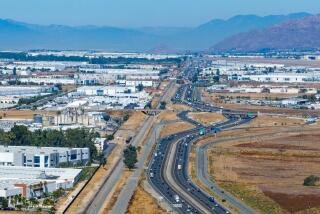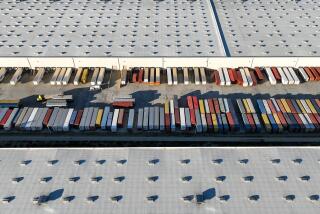Monrovia OKs Plan for Peck Road Industrial Area
- Share via
MONROVIA — A zoning plan to make an industrial area in south Monrovia more tolerable to neighbors was unanimously adopted by the City Council on Tuesday.
Dubbed the “Peck Road Specific Plan,” the ordinance will enable the city to regulate development in the area so that auto dismantling and salvage operations or “other miscellaneous industrial uses” do not disrupt about 200 homeowners in an unincorporated area west of the site.
The 33-acre area on the southwest corner of Live Oak Avenue and Peck Road is also bordered by a Monrovia gravel pit on the east, and commercial and vacant county properties to the north and south.
Now zoned for planned development, the site houses five auto salvage facilities on 22 acres, a building materials salvage yard and a roofing materials business.
2 Decades of Complaints
The plan, which had been approved by the Planning Commission 6 to 1 at its Jan. 11 meeting, follows two decades of resident complaints. It is the result of nine months of negotiations among city staff, business owners and county homeowners.
Under the plan, the major property owner, Parts Country Inc., must create and maintain a 30-foot-wide buffer landscaped with shrubbery, evergreen trees and oleanders along the 1,500-foot boundary between the businesses and homes. The east and south boundaries must also be landscaped.
Entrances on Mayflower and Live Oak avenues to the salvage yards will be closed. A common access for customers is allowed on South Peck Road, away from any homes.
The businesses may continue to operate seven days a week, although crushing activities will be prohibited on Sundays.
Implementation will begin July 1 with a Jan. 31, 1990, deadline for compliance.
Similar to 1974 Ordinance
The plan is similar to one adopted by the City Council in 1974. That ordinance also required the closing of the Mayflower and Live Oak entrances, as well as the building of an eight-foot-high earthen barrier between the yards and the homes.
But when Parts Country President Clayton Hurley challenged the law in court, the county and the residents declined to finance a defense, a city official said.
At that point the city was unwilling to spend money fighting for the ordinance because those involved were county, not Monrovia, residents. Thus, the plan was never implemented.
The area had been used as a gravel pit and later a landfill. In 1967, a mobile home park on the land was condemned by the state because the land was sinking and methane gas from decomposing garbage in the former landfill was leaking. That same year, Monrovia issued a conditional-use permit for auto dismantling businesses on the site.
Neighbors were not thrilled.
Protest from residents prompted the City Council to adopt the 1974 plan, and complaints continued after that failed.
About 170 homeowners sent post cards to Mayor Bob Bartlett last year asking him to “please eliminate the junkyards and rezone the land for more compatible use,” according to homeowner Shirley Rechtin.
‘No Other Choice’
“They were repairing cars on the street,” she said, adding that she has been complaining about odor, noise and dust from the auto wreckers since they began operations. Saying she would rather the businesses leave the area completely, she conceded that she is accepting the city’s compromise because “we have no other choice.”
Customers park their cars on residential streets, said Ken Angell, who lives three blocks from the entrance to Pick-A-Part, one of the main salvage businesses at the site.
On Sunday mornings, the line of customers waiting for the yards to open extends two blocks on residential streets, he said, trapping residents’ cars in their driveways.
“We’re around grease and stuff like that,” he said. “They do testing on old cars without mufflers. They would leave parts on the streets--seats, fenders, hoods. . . . It’s put a lot of stress on the people in the neighborhood.”
Parts Country President Hurley said mechanics sometimes had to work on the streets because there was not enough space in the yards. He noted that off-street parking will be expanded and that all the traffic would be moved to Peck Road with the new entrance.
He said he was disappointed that the council rejected his proposal to reduce the buffer width to 10 feet but said he will abide by the plan.
Richard Mandeville, an environmental consultant hired by Hurley, warned the council that the buffer could trap the methane gas from the old landfill, causing it to escape nearer the homes. But David Herrera, the city’s consultant, responded that the risk is minimal.
More to Read
Sign up for Essential California
The most important California stories and recommendations in your inbox every morning.
You may occasionally receive promotional content from the Los Angeles Times.













